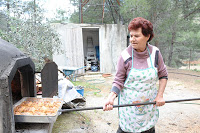And when you learn to make and eat your own flauna for so many years on Resurrection Sunday, there is no other way. "It does not smell like Easter after", explains Mrs. Eleni, who invited us to her family's summer house in the community of Kliros, to make with her the traditional flauns stuffed not with cheese, but with anari, since this way they become lighter, like us he said.
The trip to the village started around three in the afternoon, guided by Mrs. Eleni's bride, Mary. Mountain lovers, my photographer Maria and I went crazy with the beautiful route, passing through the flowery fields until we reached the family cottage which was located on a remote mountain, away from the noisy highway. Upon entering the house, our noses were tickled by the smells of the dough that was ready on the table, the well-known smell of Easter, which wakes me up every year on Good Friday morning and finds my grandmother and mother in the kitchen making our own. flaunes. Immediately Mrs. Eleni started to explain to us the preparation that is needed, while every now and then her thoughts returned to her occupied village, Katokopia Morfou. At that time, every household took care of its own flauns during Holy Week and did not just buy some of the bakeries, as it does today. "It takes a lot of hands for the flaunes and so each family made their own. That is why even on such days, meetings at home were avoided ", Mrs. Eleni tells us nostalgically.
Their preparation remains the same as before and starts on Good Friday. We start by grating the cheeses, to make the "foucault", which is the filling. At dawn the next day the process begins. After the awakening of the "foucault", to "enter", that is, in the language of the Cypriot housewives, the dough is prepared, the molding is done and they wait for the flaunes to swell. The housewives took the plates full of flavonoids and buns to the traditional wood-fired oven in the neighborhood and waited in line for baking. According to the old people, almost the whole neighborhood passed through there, as Mrs. Eleni told us, so it took a lot of patience.
The classic flauna contains cheese and halloumi, but in recent years many have shown a particular preference for anari. The reasons are various, such as the fact that it is healthier, but also because the process of preparing the dough is less time consuming. Years ago, Mrs. Eleni's mood and love for cooking led her to watch her mother carefully, to learn how to make traditional flaunes. I watch her with interest as she prepares them and I see her absolute comfort in creating the flauna and I imagine that it is so simple. He explains to me how much he looks forward to the arrival of Holy Week and the gathering of the whole family to make the flaunes, since everyone takes on a special role in the whole process. This made me think how much I share her anguish, since more or less young and old we will put our hand to make the fine traditional Easter dishes, which we will taste at the end of Lent.
After the last click of Maria's camera, which immortalized Mrs. Eleni taking the flauns out of the traditional oven of her yard, our little excursion came to an end. We said goodbye to the family of Mrs. Eleni who hosted us with pleasure and returned to the office together with the… loot of our reportage, the delicious flaunes with anari. Later, our colleagues would honor them properly, getting a first and strong taste of the upcoming Easter.
The origin of flauna
It is believed that the flauna is a Christian continuation of an ancient Greek custom, of making a kind of sweet from nuts called palati. In fact, according to Kyriakos Chatziioannou (Ta en Diaspora, BD, 1979, pp. 56-65), the name flauna came from the ancient Greek palathi (palathi> flado> fladoonis> flauna). The ancient Greek palaces were offered to the children who roamed and chanted in the houses, to welcome the swallows and consequently in the spring. It is characteristic that until recently the flauna was also offered as a tip to children or adults who went around the house to announce the Resurrection of Christ or to wake up the housewives to go to church on the night of the Resurrection.
Source: Great Cypriot Encyclopedia. Edited by: Androu Pavlidis, Nicosia (1984-1996).

